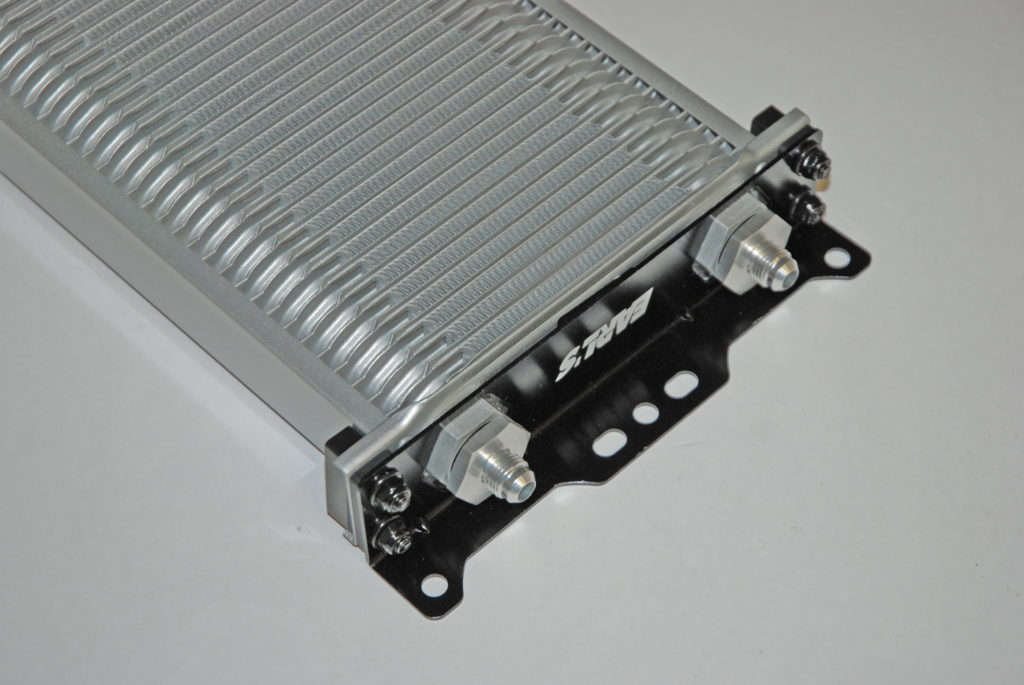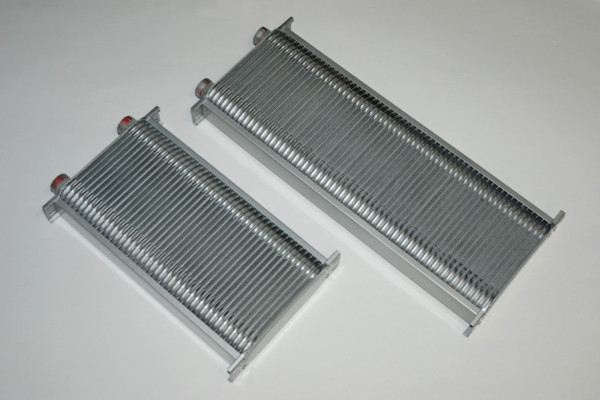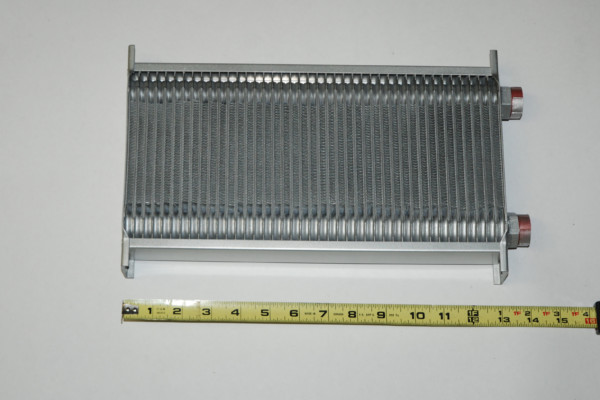It’s no secret that heat kills automatic transmissions.
This is especially true in big-power, street-strip machines that combine lots of horsepower with a small torque converter and steep rear axle ratio. Engine rpm is up across the board, and the automatic transmission builds heat. This is also true for trucks that haul heavy loads or tow trailers battling tough conditions such as long grades, high altitudes, or desert heat. In any case, loads coupled with stop-and-go traffic increase the heat level in an automatic transmission.
How Hot is Too Hot?
The ideal operating temperature for automatic transmission fluid is somewhere between 175 and 225 degrees F. Here’s what can happen above this range:
- At approximately 240 degrees F, important additives begin to cook in the automatic transmission fluid (ATF). The result is the formation of varnish inside the transmission.
- At approximately 260 degrees F, internal transmission seals, which are often manufactured from a polyacrylate material, begin to harden. The end results are internal and external leaks as the the seals lose their elasticity.
- At approximately 295 degrees F, transmission clutch plates begin to slip because the oil is breaking down further.
- At approximately 315 degrees F, seals and clutches effectively burn out. Carbon forms in the oil and for all intents and purposes, the transmission is now junk. Often, a transmission will die within a few thousand miles (or sooner) if subjected to 300-plus degree heat.
The built-in coolers that reside in the bottom of the radiator are marginal at best. A typical “in-the-rad” cooler will reduce the heat of the ATF but it’s also influenced by the engine coolant temperature. And at the same time, it too can influence the engine coolant temperature.
How can that happen?
If the vehicle in question has a thermostat that opens at 195 degrees F, once warmed to operating temperature, the transmission cooler will have a tough time reducing the heat of the ATF below 195 degrees F. At the same time, if the transmission is overworked, it might raise the operating temperature of the ATF to 250 degrees F or more. This heat can be transferred to the engine coolant resulting in a potential boil over.
So what’s the answer?
You can add an external cooler. But before you rush out and buy the first cooler available, here’s an example to ponder:
Decades ago, we built an L88 powered 1969 Camaro complete with a turbo 400, a 12-bolt filled with 4.88:1 gears and an 8-inch torque converter. It was a street-driven car, but even with a big, four-core rad, the combination was always ready to melt the transmission fluid. In a conversation with Bob Fouts at Earl’s Performance, we garnered this critical kernel of information: It is virtually impossible to overcool an automatic transmission, especially one in a high performance application. Naturally, this might not apply to vehicles operating near the Arctic Circle, but in the rest of the world, it basically holds true.
Types of Coolers
Typically, there are two types of cooler styles available: “tube-and-fin” and the “stacked plate” cooler. A conventional tube-and-fin cooler is the most common type you’ll find. Generally speaking, this cooler configuration consists of fins that are placed over aluminum tubes, which are laid out in “S” patterns. The idea is to have air flow over the fins, which in turn creates a heat sink effect. This effect draws heat from the ATF. Tube-and-fin coolers are inexpensive and easy-to-build.
The other type of cooler that is available is the “stacked plate” design. This cooler is laid out in much the same manner as the radiator in your car. Rather than using a tube to carry the ATF inside the cooler, the fins actually form the passage for the fluid to pass through. This is almost identical to the process Detroit uses to build modern radiators. This type of cooler configuration is much more efficient than the tube-and-fin style. And if you search the Summit Racing website, you’ll see all sorts of good options, including top-of-the line versions from Earl’s Performance.
The stacked plate, or “modular” cooler, has been in use since prior to WWII. During the early 1930s, it was first developed for use with the Rolls Royce Merlin engine that powered the Spitfires and Hurricanes in the Battle of Britain. It was ideal because of its dense air fins and “turbulator plates” which provide maximum liquid side (internal) and airside (external) surface area. The collector or end tanks ensure minimum flow restriction, while the fully brazed construction results in the most efficient possible thermal transfer between liquid and air. This old Rolls Royce Merlin design is the most thermally efficient liquid-to-air heat exchanger format available.
Now, you’re probably saying: “there’s a big difference between the conditions seen in an aircraft and those experienced by my street driven car.” That’s true, but these old war birds were subsonic and piston powered. In today’s terms, those old aircraft were dead slow, and because of that, heat exchanger technology has more in common with today’s trucks and cars than you might think. Plus, a heat exchanger or cooler doesn’t know if it’s cooling engine oil, hydraulic fluid, or ATF. When this basic, modular design is utilized, and the oil flow and air speed of the vehicle is taken into consideration, then the optimum heat exchanger can be produced.
Stacked Plate vs. Tube-and-Fin Coolers
How effective is the stacked plate, modular design in comparison to a more common tube-and-fin arrangement? Typically, a modular cooler (such as the Earl’s coolers shown in the photos below) will reject as much as three times the heat for a given area than a tube-and-fin cooler. The modular configuration cooler will also have less than half of the pressure drop found in a tube-and-fin cooler.
Copper-Bass vs. Aluminum Coolers
When it comes to heat exchanger construction, what’s best: copper and brass or aluminum? In most cases, the aluminum exchangers are nearly as thermally efficient as the copper and brass versions, but significantly lighter. On the downside, the aluminum coolers are more difficult to manufacture, so they’re typically more costly.
Another thing to consider is the paint. The common black paint that is preferred by most local radiator shops can act as thermal barrier instead of promoting the transfer of heat. A proper aluminum heat exchanger will either be anodized, or it will have a very thin coat of baked, heat exchanger paint (typically grey, silver, or black in color).
Fluid Cooler Mounting Tips
According to Earl’s Performance Products, the cooler must be mounted in a stream of moving air at ambient temperature to operate efficiently. It is not a good idea to mount the oil cooler behind the radiator where it will receive only heated air. It is not enough to lead air to the cooler; the heated air must have somewhere to go after it passes through the core. Air naturally flows from a region of relatively high pressure to a region of relatively low pressure, so you should mount your cooler in the airstream ahead of the vehicle radiator. That way, it will always be subject to high pressure at the face, and the engine fan will always provide a region of low pressure behind the cooler.
You also need to consider the location of the inlet and outlet ports. Coolers should never be mounted so that both the inlet and outlet ports are on the bottom. The best method is to have the ports on the top. If this isn’t possible, the next best scenario has the cooler mounted on the side so that the ports are arranged horizontally.
There are a number of ways to mount the cooler; however, Earl’s offers a slick system for their coolers. This aluminum bracket is designed to hold the cooler securely without damage from vibration. Included is a pair of brackets (with integral rubber cushions) and e-coated aircraft quality hardware with rubber insulators spacers. Earl’s offers this bracket system for all of their Temp-A-Cure cooler models.
Port configuration is usually a matter of preference. The Earl’s coolers incorporate -10 AN O-ring boss ports. From here, you simply select the AN adapter that suits your needs. It’s no secret AN fittings are less prone to leakage and obviously much more secure than pipe thread examples. A -6 AN arrangement is most common for an automatic transmission.
(article continues below slideshow)
Selecting a Cooler Size
For high performance street cars or trucks that are subjected to heavy loads or towing, bigger is always better. As we’ve already mentioned, it’s impossible to overcool an automatic transmission.
The nature of the Earl’s Temp-A-Cure cooler (shown in the slideshow) allows it to be manufactured in countless different sizes. In fact, Earl’s offers a wide array of coolers to suit almost any application. The narrow 8¼-inch wide coolers are available in heights ranging from 2 to 18½ inches. Along with the narrow coolers, you can purchase wide body coolers. The “extra wide” coolers from Earl’s have a width of 15¼ inches and heights range from 2 to 18½-inches. Finally, Earl’s manufactures curved coolers that have a width of 11.562-inches and a height from 3.05 inches up to 4.919 inches. Basically, any cooler with a face height up to 18½ inches can be created.
In the end, money that’s spent on a proper cooler is like money in the bank. Not only will your transmission live longer, it will also be more efficient.














Many thanks to Wayne Scraba for another great tech article. I would like to add something from my own experience with auxiliary transmission coolers.
One of my daily drivers is a 2002 Grand Prix GTP Sedan with the supercharged 3.8 liter V-6 and 4-speed automatic transaxle. When it had about 2000 miles on the odometer, I began all of the typical performance modifications including a smaller blower drive pulley for increased boost. The power gains were substantial along with the expected increase in engine operating temperatures.
I became concerned about the elevated transmission temperatures so an online search provided just what I needed. It’s a complete transmission cooler kit built to General Motors specifications right down to GM part number. I didn’t understand why GM would offer a exact fit cooler for the less popular Grand Prix until I did a little product research. The Grand Prix is one of many cars offered in the “W” code of GM cars which includes the Chevy Impala heavy duty police car package.
Naturally all “W” code unit body/ chassis cars are exactly the same as they proceed down the assembly line until they are selected to receive trim for the Impala, Grand Prix, Buick and Olds line of cars. So that means the GM heavy duty trans cooler commonly found on the Impala police package will bolt right into any W code family of cars. Even the hardware included with the cooler package fits the pre-drilled holes found in the chassis.
It’s a perfect fit with GM specific quality. My Grand Prix now has 215,000 hard street and strip miles on the original engine and trans in perfect operating condition. Still turning high 12 second quarter mile times. I contribute the trouble free performance to regular engine and transmission oil changes using Mobil-1 synthetic oil from the beginning. And the beat goes on…..
“A typical “in-the-rad” cooler will reduce the heat…”
I was under the impression “in-the-rad” cooler was not to cool but to get the trans up to
operating temperature quicker.
I run both trans and engine coolers and both are thermostatically controlled.
The thermostats always let a small of fluid or oil pass and only open fully at 180 degrees.
Copper Bass? Lol.
While too much cooling is less of a problem than too little it needs to be pointed out that virtually all new cars and trucks need to operate at a specific temp. Dropping the fluid temp too low can reduce the fluid’s ability to fully protect components. Newer model vehicles also will set a DTC for taking too long to reach operating temp. It’s best to use a cooler appropriately sized for the vehicle. Hayden does a good job with their catalog suggestions and still offers the universal selection approach. Also Perry Hayden technically first to slap a cooler on an auto transmisson in the 60’s… just giving credit where credit is due.
“Coolers should never be mounted so that both the inlet and outlet ports are on the bottom. The best method is to have the ports on the top”.
Why??
I’ve been researching this. and most say it doesn’t matter.
Outlet ports on the bottom trap air in the cooler. Reducing fluid penetration in the upper portion of the cooler.Reduces cooler cross section
A top outlet set up doesnt drain the ATF out of the cooler when you service the tranny. Probably the best choice would be a cooler with side mounted ports.
my ford 7.3 from the factory has them both on the bottom. when I upgraded to the 6,0 they were both on the bottom as well. Did ford get it wrong?
I meant upgraded to the 6.0 cooler. much larger and factory mounting
Right on with the fluid draining. Coolers can be installed on their side or with the fittings pointing up. appliedspeed.com
What is the pressure rating?
Coolers like those from Earl’s are rated at over 250 PSI but they are tested at higher pressures. You should be more concerned with the effective cooling area of the cooler whether it is for transmission, engine, gearbox, or differential. Stay away from “universal coolers” and the tube and fin types.
i have a 2018 ford F450 king ranch and wanted to upgrade my transmission oil cooler what size should i buy and brand
Look at a 434ERL or FP434ERL they come with 115.59 square inches of effective cooling area and the FP434ERL from appliedspeed.com come with a fan pack.
I’ve had Earl’s coolers on a few vehicles over the years and the perform with no trouble. Got a 2010 Honda van recently and those transmissions especially need cooling. One thing I cannot find about the Earl’s products (and most others as well) is the BTU cooling range for each model. Any source for that?
Thanks – Michael
Hey Michael–have you tried Earl’s own site? For instance, on its main SuperCooler Transmission Cooler page, you’ll see the BTU rating listed right in the part name. But on some others, like this model # 419ERL UltraPro cooler, you have to scroll down and open up the “Specs” submenu—but its BTU range is listed.
…
Do you have a specific model number you’d like us to check out?
I have a Honda CR-V 2005 AWD and I’ve had one transmission rebuild and two transmission replacement in less than two years. I drive mostly in the sandy region of Sahara desert. By factory default, it relies only on internal radiator for it’s cooling. Can I mount an external transmission cooler on it to extend the transmission life or is the transmission failures a factory defect?
Is a 6×8 inch stacked plate transmission cooler big enough to bypass the radiator transmission cooler in my son’s stock 2009 Pontiac G6 with a 3.5 V6? I suspect the radiator transmission cooler is plugged and have that relatively new stacked plate external cooler.
Hi I am in search of a transmission fluid cooler for a 2000 GMC C7500. It is discontinued but I am looking for a universal one with the dimensions: 4.0×17.2×16.3″
Summit Racing lists about a dozen transmission coolers available for the 2000 GMC C7500, but they don’t match your dimensions here.
…
Alternatively, you can look at all the universal coolers and then use the L x W x H search filters to narrow down to the size you need.
Hello,
I have a 2011 Silverado with a 5.3 that I occasionally tow with. While on long grads, especially while at higher altitudes, the trans temp naturally climes. I have a 210 thermostat, an aftermarket, 2-core aluminum radiator, and a fairly large tube and fin cooler. My question for improving cooling efficiency is, if the radiator is bypassed, would this improve cooling potential since the radiator is no longer looped in the fluid routing? If so, does the trans loose heating ability while in frigid conditions in regards to cold starts (if this is even a concern)?
Thank you!